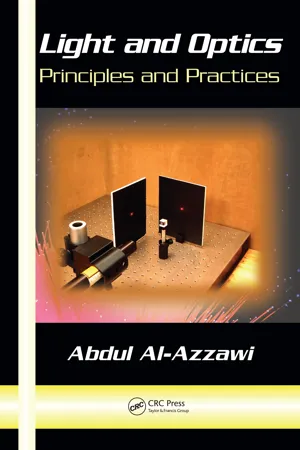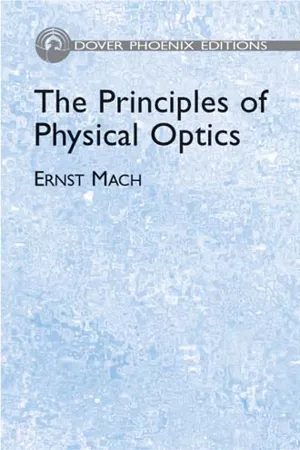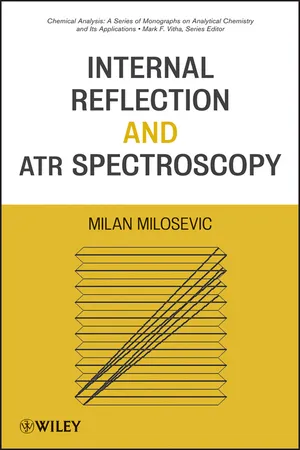Physics
Dispersion of Light
Dispersion of light refers to the separation of light into its component colors as it passes through a medium, such as a prism or a droplet of water. This occurs because different colors of light travel at different speeds in the medium, causing them to refract by different amounts. The result is the characteristic rainbow pattern of colors.
Written by Perlego with AI-assistance
Related key terms
Related key terms
1 of 4
Related key terms
1 of 3
8 Key excerpts on "Dispersion of Light"
- eBook - ePub
- R.A. Edwards(Author)
- 2014(Publication Date)
- Pergamon(Publisher)
Chapter 21 .If a beam of white light such as that from the sun or from an ordinary electric filament lamp is refracted through a glass prism dispersion occurs and the different colour components of the light emerge from the prism travelling in slightly different directions from each other. It was in this way that Newton discovered in the seventeenth century that white light consisted of a spectrum of colours. He made a small hole in a window blind through which sunlight passed producing a bright, illuminated circular patch on a screen placed in its path. When a prism was placed between the hole and the screen, in the path of the light, deviation of the light occurred but also the patch of light was considerably elongated and there was a variation in colour from one end to the other, the least deviated light being red and the most deviated being violet, as shown in Fig 23.1 . Newton distinguished seven colours—the colours of the rainbow—red, orange, yellow, green, blue, indigo and violet. A spectrum obtained in this simple manner is not a “pure” spectrum since the various colours overlap. Figure 23.2 shows an arrangement in which a pure spectrum may be obtained on a screen so that there is minimum overlapping of colours and as one progresses from the red to the violet there is a continuous decrease in the wavelength of the light incident at any point. A suitable source of light is an ordinary electrically heated filament lamp and this is used to illuminate a narrow slit. The slit is situated in the focal plane of a converging lens L which, for reasons to be explained later, should preferably be a combination of a converging lens and a diverging lens of different refractive indices and in contact with each other, such a combination being known as an achromatic lens or achromatic doublet , designed so as to produce no dispersion. The light from each point of the slit thus emerges as a parallel beam. The light is said to be collimated and the lens acts as a collimator . This light then falls on one face of the prism where dispersion occurs and the emergent light consists of sets of parallel beams of light travelling in different directions and of different colours, i.e. wavelengths, from each point of the slit. A second converging achromatic lens L′ - eBook - ePub
Light and Optics
Principles and Practices
- Abdul Al-Azzawi(Author)
- 2018(Publication Date)
- CRC Press(Publisher)
White light is a uniform mixture of all visible light. Natural light, like sunlight, is considered to be white light and contains the entire visible spectrum.Chromatic dispersion is the spreading of white light into its spectrum of wavelengths. This type of dispersion occurs when the refraction process deviates the light. The angle of deviation depends on the wavelength of the light, since the index of refraction of any optical material is a function of wavelength.The light of shorter wavelengths travels with slightly smaller wave velocities than that of longer wavelengths. This means that the prism’s index of refraction is not constant across the visible spectrum, but decreases continuously as the wavelengths increase from violet to red light. Figure 11.15 shows the relation between the light wavelength and the index of refraction of a transparent plastic material, which has the typical dispersive behaviour of decreasing the index of refraction in conjunction with increasing the wavelength.Water, glass, transparent plastics, and quartz are all optically dispersive materials. Table 11.1 lists the indices of refraction for such materials. Again, these indices are dependent on the wavelength of light.TABLE 11.1Index of Refraction for Different Materials at Various WavelengthsThe index of refraction is greater for violet light than for red light, thus violet light deviates through a greater angle than does red light, as shown in Figure 11.16 .FIGURE 11.16 White light is dispersed by a prism.11.6 FACTORS GOVERNING Dispersion of Light BY A PRISM Dispersion of white light by a prism depends on the following factors:1. The optical properties of the prism (index of refraction n)2. The angle of incidence (θ) of the light ray at the prism surface3. The apex angle (A) of the prism4. The wavelength of light (λ)11.7 DISPERSION OF WHITE LIGHT BY A PRISMIsaac Newton’s first scientific paper, published in 1672, described his experiments with light and colour. Newton passed a beam of sunlight through a prism, spreading the light into a spectrum of colours. A second prism turned the opposite way re-combined the spectrum of colours back into a narrow beam of white light. Newton found that when white light is passed through a prism, a spectrum of colours emerges as shown in Figure 11.16 - No longer available |Learn more
MCAT Physics and Math Review 2024-2025
Online + Book
- (Author)
- 2023(Publication Date)
- Kaplan Test Prep(Publisher)
Chromatic aberration, discussed below, is predominantly seen in spherical lenses.If you remember back to conic sections from your precalculus class, it should be no surprise that spherical mirrors and lenses do not focus light perfectly. Parabolas are perfect reflectors, meaning that parallel light rays are reflected perfectly through the focal point. This is used in extracorporeal shock wave lithotripsy, in which a parabolic mirror is positioned with a kidney stone at the focal point. Sound waves are reflected off of the mirror and create enough vibration in the kidney stone to shatter it.Dispersion
As discussed earlier, the speed of light in a vacuum is the same for all wavelengths. However, when light travels through a medium, different wavelengths travel at different speeds. This fact implies that the index of refraction of a medium affects the wavelength of light passing through the medium because the index of refraction is related to the speed of the wave byn =It also implies that the index of refraction itself actually varies with wavelength. When various wavelengths of light separate from each other, this is called dispersion. The most common example of dispersion is the splitting of white light into its component colors using a prism.c v.If a source of white light is incident on one of the faces of a prism, the light emerging from the prism is spread out into a fan-shaped beam, as shown in Figure 8.13. This occurs because violet light has a smaller wavelength than red light and so is bent to a greater extent. Because red experiences the least amount of refraction, it is always on top of the spectrum; violet, having experienced the greatest amount of refraction, is always on the bottom of the spectrum. Note that as light enters a medium with a different index of refraction, the wavelength changes but the frequency of the light does not.Figure 8.13. Dispersion in a PrismDue to their different speeds while inside the prism, the various wavelengths of light are refracted to different degrees.Chromatic Aberration
Chromatic aberration - eBook - ePub
The Principles of Physical Optics
An Historical and Philosophical Treatment
- Ernst Mach(Author)
- 2013(Publication Date)
- Dover Publications(Publisher)
The Fraunhofer lines form an excellent means for the exact definition of different kinds of light. It is much more precise to speak of the refractive index of the D line, or of the light emitted by glowing sodium vapour, that is to say, of the component of sunlight which is absent at the same place in the spectrum, than merely of yellow light, which comprises several kinds of light of different refrangibility. The discovery was therefore very important in connexion with the theory of. dispersion.A determination of the refractive index of the Fraunhofer lines in different substances very soon brought the conviction that refraction and dispersion bear no simple relation to one another. The table on p. 112 gives the refractive indices for several media.Denoting the refractive index of B by µ B , that of E by µ E , and that of H by µ H , µ E represents the mean refractive index, while µ H − µ B is a measure of the dispersion. We thus see that the mean refractive index and the dispersion do not run in parallel. The mean refractive indices of two substances do not in any case bear the same relation to one another as their dispersions; for example, for crown glass and oil of cassia, the mean refractive index is almost equal, whereas the dispersion of oil of cassia is about three times that of crown glass. Oil of cassia refracts the red rays less and the violet more than crown glass. The distribution of the colours in the spectrum with different substances, also, is not geometrically similar; flint glasses, for example, draw out the violet part of the spectrum proportionally more than the other parts. Let the different kinds of light corresponding to the lines A, B, C, . . . H be represented by a succession of points marked off as abscissæ along an axis. If lengths proportionate to the refractive indices are marked off as ordinates from each of these points, then their extremities form a curve, which is called a “dispersion curve.” It follows from the above that such dispersion curves have different shapes for different substances.FIG. 99 .The refraction and dispersion through a prism of a beam of white light incident on one face can easily be followed by means of a two-fold application of Snell’s construction (Fig. 99 ). An arc of a circle of arbitrary radius r is described with the intersection of the prism faces as centre, in a plane perpendicular to them. Two other arcs of radii, r 1 and r 2 , such that r 1/ r = µ r , r 2 /r = µ v , the refractive indices for red and violet respectively, are also drawn. If SK represents an incident ray, and SUV is perpendicular to the first face and UR, VV perpendicular to the second face of the prism, then UK, KV represent the two rays in the glass, and RK, VK the rays which emerge into the air. Suppose a prism with sharp edges (Fig. 100 ) is placed on a horizontal sheet of paper, and the intersections of the edges with the paper are marked. Let a beam of sunlight be made to pass through a small slit so that it is incident on the prism and also grazes the paper. Then, by reversing the above construction, the refractive indices may be determined. In this case KA, KB, SK, RK, and VK are given. The arc r is drawn with arbitrary radius, and the intersection of the perpendiculars VV, UR, S“V give the radii r 1 and r 2 - eBook - ePub
- Pradeep Fulay, Jung-Kun Lee(Authors)
- 2016(Publication Date)
- CRC Press(Publisher)
In this section, we will quantitatively study refraction, reflectance, scattering, and transmittance of light traveling in materials. We will show how the direction and intensity of propagating light change at the interface of two materials with different refractive indices and how the microscopic view of the refractive index (vibration of free electrons and oscillation of bound electrons) is correlated to the macroscopic property of light.8.4.1 REFRACTION AND REFLECTION OF AN ELECTROMAGNETIC WAVE AT A FLAT INTERFACEWhen light enters from air to water, we know that the traveling direction of light is altered at the water–air interface unless the traveling path of the incident light is normal to the water–air interface. This light bending is called refraction, and it is a consequence of a change in light speed (or wavelength). Refraction is common in our daily life. For example, white light is refracted at the prism–air interface and visible light with color is separated (see the left plot of Figure 8.13 ). In addition, refraction on the surface of a convex lens helps us to see objects more clearly. Also, silica glass fibers deliver light without energy loss by using refraction.The right plot of Figure 8.13 intuitively explains the refraction of light. If light travels from air to glass at an incident angle of θ1 , light experiences refraction due to the change in light speed. As shown in Figure 8.13 , light traveling a distance along Path 1(and Path 2)B D¯(is not the same because light speed is different in air and glass. Let us represent the traveling distance in air and glass as d 1 and d 2 , respectively. If Medium 2 has a higher n than that of Medium 1, light speed (or wavelength) in Medium 2 decreases and d 1 is larger than d 2 . Because of a difference in d 1 and d 2 , the refraction angle of θ2 is not the same as that of θ1 , and their relations are obtained from geometric consideration:)A C¯=d 1sinθ 1d 2sinθ 2FIGURE 8.13 (a) Due to refraction by a glass prism, red, yellow, green, blue, and purple components of white light are split at glass–air interfaces. (From Encyclopedia Britannica - Bill Woodward(Author)
- 2014(Publication Date)
- Sybex(Publisher)
To explain refraction, we have to look at the wave nature of light. Recall that light consists of two perpendicular waves, and that the light travels in a path that forms right angles with both waves.As the light wave meets the boundary between media with different refractive indexes, that portion of the light wave changes velocity or it experiences a phase velocity change, while the rest of the light wave maintains its original velocity. A change in the phase velocity of a light wave typically causes the light wave to change direction as described by Snell's law, which is discussed in detail later in this chapter. Figure 3.8 shows light waves changing direction because of a change in phase velocity as multiple light waves cross from a lower refractive index into a higher refractive index.Light waves changing direction because of a change in phase velocityFigure 3.8The velocity of light through different media such as glass depends on the light's wavelength. One of the most common ways to observe this is by seeing how white light is refracted through a prism and broken up into its component wavelengths, as shown in Figure 3.9 . Notice that violet, which has the shortest visible wavelength, is refracted more than red, which has the longest visible wavelength. In this example, the red light changed direction the least and is traveling the fastest through the prism, while the violet light changed direction the most and is traveling the most slowly through the prism.It is important to remember that different wavelengths of light travel at different speeds in an optical fiber.Refraction of white light into component colorsFigure 3.9Calculating the Index of Refraction
We know the velocity of light can change and its velocity depends on its wavelength and the index of refraction of the medium it is passing through. We also know that the higher the refractive index, the slower the light travels. In other words, the speed of light (c- eBook - ePub
- Milan Milosevic(Author)
- 2012(Publication Date)
- Wiley(Publisher)
1 Introduction to Spectroscopy1.1 HISTORY
Spectroscopy got its start with Newton’s observation that the white light from the sun can be separated into different colors using a prism. This observation became not only foundational to the theory of light but also to the understanding of human color vision. Color vision is a crude form of spectroscopy. We can often guess on the nature of a material by its color. We can only perceive three primary colors. That makes the human eye a very crude spectrometer. However, even at this crude level, it was apparently advantageous to us, during evolutionary history, to trade higher image resolution for color vision.In the times of Newton, the hurdle to overcome was to understand the nature of light. Newton himself proposed the so-called corpuscular theory of light with which he was able to explain all then known properties of light (i.e., the propagation of light in a straight line and the laws of reflection and refraction). Newton proposed that light consists of tiny particles (corpuscles). Huygens, a contemporary of Newton, proposed the so-called wave theory of light, in which light is a wave phenomenon like a wave on the surface of water. Using his theory, he too was able to explain all the known properties of light. To make their respective theories work, Newton and Huygens made opposite assumptions about the speed of light in optically transparent media such as water or glass. Newton needed light to go faster through such media for his theory to work. Huygens needed it to go slower.However, what settled the dispute was not the measurement of the speed of light in transparent media; it was the observation that light can form interference patterns. Only waves can form interference patterns and that settled the dispute. Huygens won. Later, measurements of the speed of light in denser media such as water confirmed Huygens’s assumption. Light was a wave phenomenon.Different colors of light correspond to different wavelengths. In studying light dispersion by a glass prism, Herschel noticed that there is an invisible component of solar radiation next to red light. Thus, infrared (IR) light was discovered. Later, it was discovered that there is also an invisible component of solar radiation next to violet that was named ultraviolet (UV). - eBook - ePub
- Jeremy Sanderson(Author)
- 2019(Publication Date)
- Wiley(Publisher)
2 LightOutline
2.1 Introduction- The importance of light
2.2 The Nature of Light- Newton splitting sunlight with a prism
- Newton’s view of the corpuscular nature of light
- Huygens, Young and Fresnel’s view of the wave nature of light
2.3 The Nature of Waves- Periodic harmonic motion
- Mechanical and electromagnetic waves
- Characteristics of waves
2.4 Wave-Particle Duality- Maxwell’s equations of electromagnetic waves
- Planck and Einstein’s introduction of energy quanta
- The photoelectric effect
- The wave-particle model of light
- The origin of light
2.5 The Visible Light Spectrum- The spectral colours
- Newton’s classification of the visible spectrum
2.6 Important Properties of Light- Monochromaticity
- Coherence
- Collimation
- Polarisation
2.7 Interaction of Light with Matter- Absorption
- Reflection and refraction
- Scattering and diffraction
- Phase change
- Polarisation
- Fluorescence
2.8 Reflection of Light- Reflection of light
- Specular and diffuse reflection
2.9 Refraction of Light- Basis of refraction
- Refraction as a change in velocity
- Snell’s law
- Fermat’s principle of least time
- Homogeneous immersion
2.10 Total Internal Reflection- Basis of total internal reflection
2.11 Dispersion- Basis of dispersion
2.12 Refraction and the Action of Lenses- Lenses as a series of prisms
- Principal focal points and focal planes
2.13 Chapter Summary- 24 points
Key ReadingReferencesFurther ReadingInternet Resources2.1 Introduction
Having emphasised in Chapter 1 that all images are seen by the eye, this chapter considers the start of the imaging process: light. We shall discuss what light is and how it interacts with matter. We shall consider how the velocity of light is altered by materials denser than air and how rays of light are bent or refracted.Light is so central to our perception that for much of the time we are unaware of it and take it for granted, except perhaps when viewing a gorgeous sunset or glimpsing crepuscular rays behind clouds. Although light surrounds us and is essential for life, it is anything but ordinary. As one popular science writer has put it: ‘Light, the universal metaphor for understanding and revelation, is astonishingly opaque’ (Brooks, 2012). The Greeks were aware of the importance of light, referring to dying as ‘losing the light’. Yet it is only in the last 200 years that humankind has begun to understand light’s unique properties. Indeed, Benjamin Franklin remarked in a letter discussing science to a colleague, written in April 1752, ‘I must own that I am much in the Dark about Light…
Index pages curate the most relevant extracts from our library of academic textbooks. They’ve been created using an in-house natural language model (NLM), each adding context and meaning to key research topics.
Explore more topic indexes
Explore more topic indexes
1 of 6
Explore more topic indexes
1 of 4







